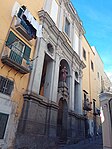Virgil's tomb
Archaeological sites in NaplesBurial monuments and structuresTombs in ItalyVirgil

Virgil's tomb (Italian: Tomba di Virgilio) is a Roman burial vault in Naples, said to be the tomb of the poet Virgil (70–19 BC). It is located at the entrance to the old Roman tunnel known as the Crypta Neapolitana or grotta vecchia in the Piedigrotta district of the city, between Mergellina and Fuorigrotta.
Excerpt from the Wikipedia article Virgil's tomb (License: CC BY-SA 3.0, Authors, Images).Virgil's tomb
Salita della Grotta, Naples Chiaia
Geographical coordinates (GPS) Address Nearby Places Show on map
Geographical coordinates (GPS)
| Latitude | Longitude |
|---|---|
| N 40.829583333333 ° | E 14.217555555556 ° |
Address
Parco Vergiliano - Tomba di Virgilio
Salita della Grotta
80122 Naples, Chiaia
Campania, Italy
Open on Google Maps










